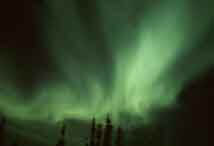
Northern Lights
Picture yourself outside on a clear dark night. You notice a faint glow of greenish light stretching across the sky. Then additional bands of light form slowly brightening to form a giant curtains that slowly waves across the sky. The lights change to red and then blue and purple. The entire sky seems to be full of color and motion. Then everything fades into a warm green glow. You are experiencing the Northern Lights.
Early scientific explanations for the Northern Lights concluded they were sunlight reflected from arctic ice, or light reflected from ice crystals high in the sky. Today we know the Northern Lights occur when electrons accelerate into the upper atmosphere along Earth's magnetic field lines. The electrons collide with gas atoms and emit light. This reaction is similar to the way neon lights glow when an electrical current excites the gas inside a neon light tube. The movement of the Northern Lights is caused by solar wind.
No two Northern Lights are the same. They are always different sizes and different colors. The colors are determined by what type of molecule strikes the atmosphere and where. If the lights occur at: * 200 miles up, high-level oxygen makes the lights glow red. This is very rare. * 60 miles up, the oxygen glows a very bright yellowish-green. This is the brightest and most common of the Northern Lights.
If the particles hit some nitrogen molecules in the atmosphere, the Northern Lights will glow blue or purplish.
Why not Experience the Beauty of the Northern Lights yourself?



